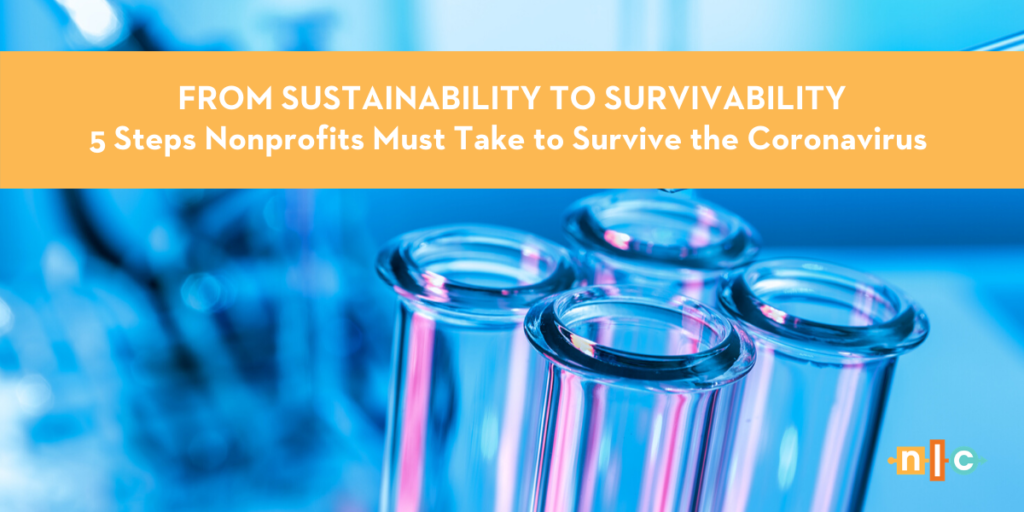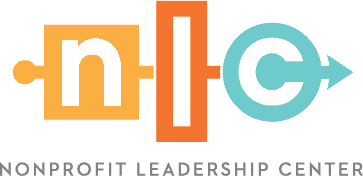In the nonprofit sector, the fragility of life is always present. Likewise, for nonprofit leaders, the fragility of our organizations is also always present. Fears of an impending recession and the decline in the percentages of individuals donating to nonprofits have made organizational sustainability a top concern for executive directors for quite some time. But none of us expected the sudden disruption of our lives and society brought on by a pandemic.
As nonprofit professionals scramble to devise new operating plans to serve as many as possible while protecting and caring for employees, the thought of sustainability seems almost quaint. All revenue streams, from foundations to individuals and even fees for service, are under extreme pressure. Indeed, for many executives, thoughts today are not on sustainability, but survivability. And, as always, it’s at these times our constituents need us most.
The initial steps to respond to the pandemic have varied by organization type, with the focus being on humanity – serving our constituents – as well as safety and protection. Arts and culture organizations, educational institutions and other community organizations have closed their doors for extended periods, while several social service organizations continue to operate, balancing constituent service with social distancing. One constant across the sector has been the canceling of spring fundraising events and the upheaval of development plans. As organizations struggle to maintain operations, payrolls or both while revenue is decreasing, there are steps they can take to increase the likelihood of success:
- Understand your cash position.
- Assess revenue streams and damage.
- Look at the dual bottom line.
- Include everyone in the discussion.
- Communicate consistently.
Let’s explore each of these steps.
(Don’t want to read? WATCH how to do it here.)

Understand Your Cash Position
Cash is king. With expenses continuing and revenue on hold, knowing your cash position serves as a foundation for action. Certain common ratios like the quick ratio or current ratio calculate whether your organization has enough cash to pay its bills today, but they don’t provide guidance on how long it can weather this disruption. The best ratios for that help with understanding your liquid reserves:

This ratio calculates how many months of savings your organization has if it operates at its current rate and receives no additional income. The numerator subtracts restricted cash and receivables, assuming your organization will not be able to perform the work necessary to release those revenues. The denominator is simply your annual budgeted expenses divided by 12 months. This is the purest form of a reserve. It allows leadership to understand how much time they have to stabilize the organization. For many organizations, this is somewhere between two weeks and four months.
For organizations that have ceased operations but are committed to maintain payroll as long as possible, a separate calculation may be useful, which only includes essential expenses in the denominator (payroll, health insurance and occupancy-related costs):

This formula lets leadership see how long their current position allows them to maintain these basic expenses. In this ratio, we’ve excluded receivables, but they can be included if your organization believes there is a high likelihood of collecting them.
These formulas are the simplest way of calculating and monitoring the organization’s savings. A more strategic approach would be to prepare or update your organization’s cash flow projections for the next six months, showing expected inflows and outflows of cash. With the ratios as a foundation and the cash flow projection as a tool, leadership can work with the board to build scenarios. At the very least, leadership can monitor the urgency of the situation and make informed decisions about how to continue.
Assess Revenue Streams and Damage
The formulas above focus on the organization’s expense side, assuming no additional income. Nonprofits must also pay attention to revenue. Many foundations are attempting to continue grantmaking, and many local government agencies are seeking to fund expanded social service activities for vulnerable populations with emergency dollars. Therefore, revenue projections that take into consideration our new reality can be inputted into the cash flow projection for a more realistic picture. While it is conservative to assume your organization will not receive any new income, acting on a “worst-case scenario” does not necessarily lead to strategic or beneficial decision making.
Revisiting revenue streams also allows leadership the opportunity to discuss revised plans and focus on those efforts where the organization has the strongest relationships and greatest likelihood of securing funds. For example, some special events have already moved online, with operas live streaming performance and social service agencies holding online auctions and sending videotaped messages to supporters. While less revenue has been raised, there may have also been fewer expenses. This is also the time to identify areas where board members might have relationships and could meaningfully engage in sharing the fundraising workload.
READ NEXT: How to Mitigate Revenue Loss During Uncertain Times
Look at the Dual Bottom Line
When cash gets tight, the financial bottom line becomes readily apparent. But in stressful times, it’s important to consider both bottom lines: impact and financial. Especially if challenging decisions need to be made about where to focus, consider the impact of each program and fund the highest-impact programs first. This is often a difficult discussion. Everything an organization does has value. But given the current situation in which we find ourselves, which aspect of the organization has the most value today? Are there longer-term programs or projects that could be put on hold? Could unrestricted resources and staff be transferred to efforts with the highest impact, such as direct services? Could reducing expenditures on lower impact programs allow your organization to build cash reserves?
This is especially helpful if cuts need to be made. One common response to a crisis is to implement a straight percentage cut across all activities; however, this is not the most strategic decision. Yes, it avoids conflict, but focusing on programs where there is an intersection of organizational strength and pressing constituent need is essential. Not only does this allow organizations to most effectively have impact and accomplish their missions with available resources, but it also helps make the case for increased support to funders.
The matrix map visual is a helpful way to highlight both the impact and profitability of an organization’s programs and look holistically at how each organizational program contributes to impact and financial viability. While the process of completing a detailed map can take some time, a rapid version can be created in an afternoon. Remember, the map is a representation of the business model used to inform decision making, not a 100% accurate picture. In some cases, some information is better than complete information, especially when the goal is to bring others along in the discussion and make decisions. This is one of those cases.
Include Everyone in the Discussion
Speaking of bringing others along, there are no “right” answers to these challenging questions, and ideas for sustaining the organization know no positional boundaries. Engaging everyone in these candid conversations can often surface new approaches or meaningful strategies. That said, programmatic staff may be overwhelmed and overworked responding to the crisis, and leadership will need to decide whether it is appropriate to add to their workload by bringing them into the conversation. However, our default position is that nonprofits are community organizations responding to a community challenge, and they benefit from the input of close community members during these difficult times. Our desire is for everyone to have a voice.
Determining the organization’s cash position, described above, will inform how much time leadership has to meaningfully engage a broad group of people in a discussion. At a minimum, however, board and senior leadership should be involved in surfacing potential solutions. Ideally, these positions will be informed by staff and constituents. Especially for social service organizations, it is important that the needs of those being served are well known and represented in the discussions.
Again, the easy solution in these times is for a small group at the top of an organization’s leadership to come together and make decisions, but this group may not be as well informed about constituent needs as others. By opening the discussion, unexpected opportunities might surface. Additionally, by sharing the complexity of the decision to be made and the options to consider, leadership helps to build community and buy-in for implementation.
Communicate Consistently
Our last point may be the most important. Often in times of crisis when leadership is busy trying to serve constituents and make informed decisions to save their organization, communication can lapse. Leaders may feel they have “nothing new” to say or they might not yet have a “path forward” or solution for the organization and therefore don’t communicate to key stakeholders. Unfortunately, while understandable, this is the wrong course of action.
Nonprofit organizations are expressions of our humanity – people coming together to build stronger, more enriching and more equitable communities. By expressing the hardship that our organizations are experiencing and the difficult choices that must be made, we invite others to participate in the process.
We are all joined together in this time, living through a pandemic the likes of which none of us have ever seen. This is especially true of donors. Helping donors understand firsthand what your constituents and the organization face allows them to support you in the most effective manner. We cannot only talk with stakeholders when things are going well. Helping everyone understand that the organization is maximizing impact and leading with its values – with the needs of our constituents and staff front-of-mind – strengthens the connection and relationship donors feel with the mission. This connection will be necessary for organizations to survive this shock and ultimately be able to thrive once again.
Time is of the Essence
None of the steps here are easy, especially in a time of crisis. Given this rapidly evolving pandemic, it is tempting to put off decision making to see how the situation progresses. One lesson from the Great Recession, however, was that those organizations that assessed their situation earlier were able to make strategic decisions which resulted in less severe measures later. Nonprofit leaders face competing demands and priorities as they deliver on their missions. By inviting others in, communicating clearly, looking at the organization holistically, and understanding where we’re starting from financially, leadership can attempt to spread the workload, build commitment, surface strategies and implement solutions to help their organizations – and our communities – survive and, once again, eventually thrive.
Watch Steve walk through each of these steps in this one-hour video.
Steve Zimmerman is the Principal of Spectrum Nonprofit Services and the co-author of The Sustainability Mindset and Nonprofit Sustainability. He can be reached at stevez@spectrumnonprofit.com.

